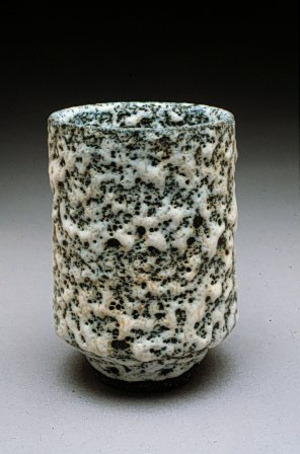 |
| Lucy Rie |
These are notes from a few scraps that were found swirling around. Been looking for anything I could find regarding the glaze shown above.
If anyone has any more tidbits, I'd be really keen on adding it to the pile.
Pottery/glaze recipe.
Advertisement
Question
I am looking for a "crater"type glaze similar to those used by Lucy Rie, the english potter. I dont think she shared her recieps widely. A matt, firly thick buttery glaze that forms craters due to the release of gasses close to its melting point. I fire cone 9. 1260.C. any Idea? Thanks Chris.
Answer
Dear Chris,
Thank you for your recent question. Crater glazes are also known as volcanic or froth glazes. Although these are commonly described as defects, a glaze purposely created for this type of "defect" is no longer considered a defect to the glaze surface, but a decorative surface. Lucy Rie purposely created glazes to achieve this type of effect, but there are other potters who find the froth surface a unique and beautiful design, if done correctly.
The key to a froth or volcanic glaze is silicon carbide or barium sulphate. These two ingredients create a bubbling effect under the glaze. When fired, the kiln must be turned off and temperature brought down to a dull red at a specific time in order to achieve the effect. Although commonly performed on low fired ceramics, this process can be achieved on high fire, if you take the time to watch your kiln.
To create the volcanic reaction, create a slip using the same clay body your pot is made from. For every 100 grams of wet slip, add 10 grams of silicon carbide or barium sulphate. Sieve into a 300 mesh sieve. Mix and apply where you wish the froth to take place.
Use the recipe below and glaze your pot as normal. The recipe will create a buttery glaze matt at cone 9
Custer Feldspar 50
Dolomite 20
Cadycal 100 5
EPK Kaolin 25
Colorant
Vanadium Oxide 5
Once the glaze has been applied and you are ready to fire, careful watching of the kiln near the maturing point is essential to achieve the froth. Viewing the glaze through the peephole will allow you to see when the kiln should be turned off. You will see an orange peel affect and even some popping of the glaze. This is when the temperature should be reduced.
Although this is my way of achieving the froth effect, please test this method on sample tiles prior to using it on your work. Let me know if I can be of further service to you. Good luck!
Sincerely,
Ti Phillips
Earth Stoke 'N Fire Pottery Studio and Artist Retreat
www.earthstokenfire.com
Technical Notebook
I first used silicon carbide between 1971―73 at 1300°C in a reduction atmosphere stoneware kiln.
Modified Daniel Rhodes Clear Porcelain (Stoneware and Porcelain, p.82)
Silica 32
Whiting 20
Feldspar 33
Kaolin 15
Zinc oxide 15
Silicon carbide (600 mesh) 20
This glaze contains a ridiculous amount of silicon carbide to produce the volcanic effect, but I also used it for its greyness.
The post-London pieces after 1977 initially had the following slip banded onto the leather-hard turned piece:
Silicon Carbide Slip
Body clay 100
Whiting 50
Silicon carbide (400 mesh) 3
Using a reactive slip means you can place it where the froth from the covering glaze is not going to stick to the kiln shelf. The ultimate slip is achieved by putting the additive directly into the clay. I use this technique for pitted agate.
In later work I cut out the slip stage and mixed two versions of the glaze, the second with 3% silicon carbide added. Because I spray my glazes, I am able to spray the foot and grade upwards with the non-reactive glaze and then do the rest in the reactive. It achieves the same result as placing the slip and avoids pitting near the base. Yet using a slip is more precise, as it produces a definite cut off point.
The following two glazes are oxidised to 1220°C.
Matt Magnesia/Zinc
Potash feldspar 31
Whiting 20
Talc 10
Kaolin 29
Silica 10
Zinc oxide 10
This was originally a Len Castle high temperature reduction glaze to which was added 10% zinc oxide to melt at a lower temperature
Tourquoise Matt
(from Ceramics Monthly, July 1984, p.66)
Barium carbonate 24.4
Dolomite 12.2
Petalite 12.2
Cornwall stone 12.2
Nepheline syenite 12.2
Kaolin 12.2
Silica 14.6
Tin oxide 4.9
Copper carbonate 3.5
The reaction between the silicon carbide and the copper carbonate often produces local artificial reduction resulting in copper reds. If the froth is ground off, the red becomes more prominent.
 Here's a absolutely golden opportunity to participate in the next generation of learning. This is the notion of the "community classroom" put into motion by non other than Diana Fayt.
Here's a absolutely golden opportunity to participate in the next generation of learning. This is the notion of the "community classroom" put into motion by non other than Diana Fayt.













